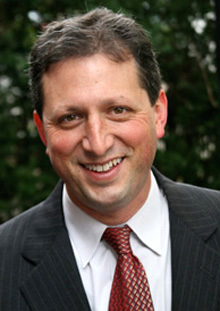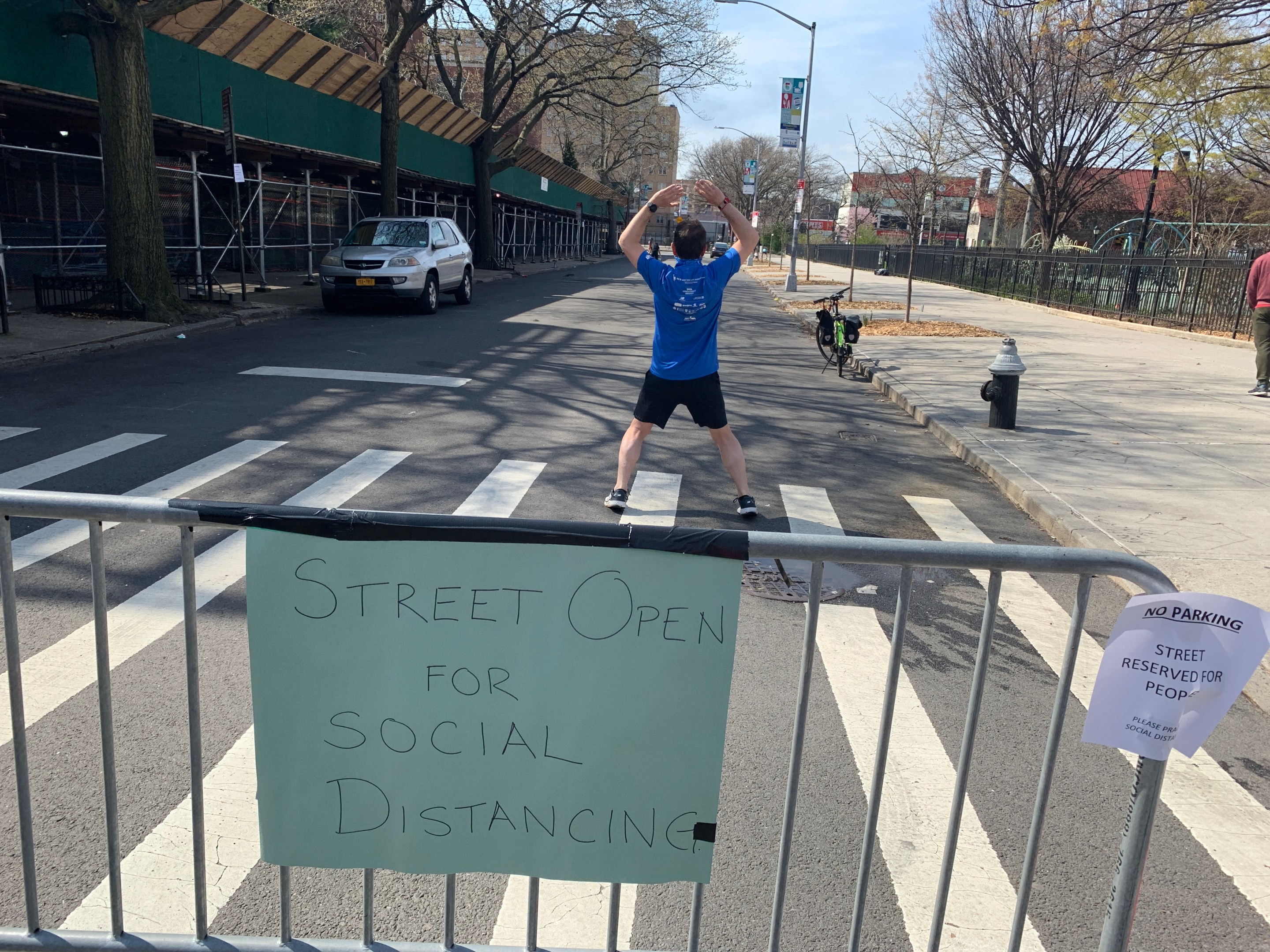The following is a collaboration between Streetsblog, which covers the movement for livable streets, and Chalkbeat, which covers education.
A Brooklyn lawmaker has joined the growing chorus of parents and activists calling on the city to close streets around school buildings for use as car-free space for recreation, lunch, small group instruction and other activities.
In just two days, City Council Member Brad Lander received proposals from 14 schools from his district — stretching from Boerum Hill and Park Slope to Sunset Park and Kensington — to use surrounding streets. He called on the Department of Transportation to establish an “Open Streets: Schools” program to help coordinate and oversee a citywide operation.

“Families, teachers, school staff and many others are deeply concerned about the safety of sending students back to indoor school in the fall, about whether their school facilities can be made safe (e.g. what about the schools where windows don’t open),” Lander wrote Thursday to the transportation department.
Lander’s letter is part of the effort to maintain social distance guidelines while providing in-person learning this year. Schools are figuring out how to safely hold socially distant classes for their hybrid of in-person and remote schedules, opting to repurpose cafeterias, auditoriums and even office space as classrooms. The push to look outdoors comes as much of the scientific evidence points to less transmission of the coronavirus outside, and as many families remain concerned about the ventilation inside classrooms despite promises from city officials that HVAC systems and ventilation upgrades are underway. Schools are also grappling with how to figure out how to follow social distancing rules with limited space, which means that most children will attend school next year between one and three days a week.
“This is especially dire for students in our most crowded schools, who may end up with up to 66 percent fewer school days simply by virtue of where they live,” Lander wrote.
The letter suggests that blocks could be closed to traffic during school hours to make room for students. Temporary tents could be set up for shade or rain protection, or in some cases, blocks could be fully closed to allow schools to set up semi-permanent tents and outdoor classroom spaces.
Several campuses on the Upper West Side are also discussing proposals to make use of surrounding streets. At P.S. 165, where Nayia Frangouli’s son is a rising third grader, parent leaders presented its principal with several options, including using existing fenced playgrounds as well as sharing West 108th and 109th streets with the Mott Hall II, a middle school that shares its building.
“My wish is that our school’s administrators understand the benefits for all: themselves, our teachers, and our children, to move ahead with an outdoor learning plan,” Frangouli said. “A lot of families I know are thinking of not returning if we continue indoors and that will create social/emotional imbalances for their children.”
Closing streets to traffic could touch off a fierce fight over parking around schools, particularly if an increasing number of teachers opt to drive to work instead of taking public transportation. Teaching outside would also be a major shift for educators who are accustomed to having their supplies and desks indoors.
Mayor de Blasio said on Thursday that he is “open” to the idea of closing roadways to cars, even as his administration does not appear to be planning for such a use of space.
“We’re going to look at that,” the mayor told reporters on Thursday when asked about a petition demanding, by Aug. 2, “a plan to close streets adjacent to or near each school building.” [To view the petition, click here.]
The mayor added that “outdoor space could be really valuable,” but cautioned that it “won’t work when it gets colder [and] won’t work on bad weather days.”
Let’s have school outdoors next year! Sign the petition ! : https://t.co/JOxZr7VfNF
— leonie haimson (@leoniehaimson) July 22, 2020
One of the parents who created the petition last week was disappointed by the mayor’s response — arguing that with proper advance planning, the city could help school principals prepare for anything.
“Of course, closing streets to cars and setting up tents is a big task, but so is holding classes during a pandemic,” said Mike Meade, who has two children in Brooklyn public schools. “We’re just asking them to be more creative than they might have been.”
Meade cited the mayor’s “open streets” program, which currently bars thru-traffic on more than 60 miles of roadways around the city, as evidence that the de Blasio administration could easily bar cars from school streets, too.
“I don’t know if the mayor is taking it seriously,” Meade said. ”Principals need to know that they have the option of closing a street as part of their reopening recommendation to the Department of Education. But we haven’t heard any proactive steps from the DOE or from any other city agencies.”
City officials haven’t told principals they have such an option. The “School Building Re-Opening Preliminary Plan,” shared with principals on July 8, does not refer to outdoor space or roadways. The only reference to space is a recommendation that principals report whether they need to “repurpose space within schools.” (Emphasis added.)
City officials have subsequently said they are looking at potentially repurposing other buildings for school use, but have yet to provide details on such plans.
On Thursday, Mayor de Blasio disagreed with Meade and Lander on the imperative to act.
“We still have a good amount of time before the school year starts,” he said.
Parent Group Calls for at Least 30% of Public School Learning to be Outdoors This Fall https://t.co/UM3uyB9Pdv
— Cynthia (she/they) (@CynthiaMassonTE) July 23, 2020
It’s not the first time that city officials have been asked to consider taking back public roadways around schools from car drivers, who killed 10 children in crashes in 2019, according to Streetsblog’s analysis.
Last year, amid one of the most deadly years for road fatalities in decades, Streetsblog asked Schools Chancellor Richard Carranza if he had ever asked the mayor to bar cars from school roadways to keep children safe from automobile traffic, which is one of the top two leading causes of death for kids.
“We have 1,300 school buildings, 1,800 schools, so it’s more of a logistical concern that is outside my purview,” Carranza said.
In a follow-up question, Carranza admitted that there are only two topics he and the mayor discuss. “Curriculum and instruction,” he said. “Never streets.”
Meade said his petition, which generated more than 2,700 signatures in just a few days, was being discussed even before a New York Times column called for outdoor schooling, much as the city did during earlier epidemics.
Ginia Bellafante's column cited multiple examples of schools around the country that took their instruction outdoors, even in the cold.
“Distressingly,” she wrote, “little of this sort of ingenuity has greeted the effort to reopen schools amid the current public-health crisis. In New York, the nation’s largest school system, students will attend live classes only a few days a week, a policy that has angered both exhausted parents, who feel that it is not nearly enough, and many teachers, who fear it as way too much.”
Additionally, a recent survey of roughly 400 families and educators from advocacy groups Class Size Matters and NYC Kids PAC found strong consensus that outdoor space, including streets outside of schools, should be used when possible.
The use of outdoor space is one of many question marks about the coming school year. Parents still don’t know if their children are eligible for one-, two- or three-day in-person instruction under the blended learning model. And the education department has not released a plan for the 150,000 students who rely on school buses.
Without school buses, tens of thousands of parents might find themselves driving or accompanying their children to school in taxis, which could add tens of thousands of cars to roadways packed with children — an obvious threat to public safety.
De Blasio said the city would announce a plan for school buses before the academic year begins.
“School buses will be part of the lineup as per usual,” he said.
After initial publication of this story, Department of Education spokesman Nathaniel Styer said, "As we prepare for a school year unlike any other, school leaders will be making the best use of all the safe spaces available to them – including outdoor spaces. We are exploring all feasible options and appreciate community feedback as we develop new ideas on how to utilize space.”






